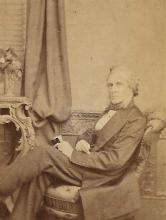Bio of time in Hong Kong By Rudi Butt:
Anderson (b. April 16, 1809 (or 1810), Selkirk, Selkirk, Scotland – d. May 28, 1857, Jedburgh, Roxburgh) went to Macau in July 1834 (and thence onto Canton) as an assistant surgeon attached to the mission of William John Napier, 9th Lord Napier (b.1786-d.1834), the first British Superintendent of Trade in Qing China.
He was given charge of starting up a hospital ship in Whampoa in the month next following his arrival chiefly to look after British seamen. The hospital ship project was proposed by Thomas Richardson Colledge (b.1796-d.1879), head surgeon of the Napier mission who had been living in China since 1827 as surgeon for the British East India Company. The project was stopped before preparations began in earnest amidst growing hostilities between Napier and the government in Canton, which was tasked by the Qing court to handle all foreign diplomatic affairs. Anderson stayed behind in Macau after Napier died in October the same year having achieved nothing for his commission. As a surgeon to the British mission, he assisted British ships which had no surgeons on board at where they anchored either in Lintin (Nei Lingding Island) or Kumsing Moon to look after sick seamen. In addition, Anderson had frequently assisted in important operations at Ophthalmic Hospital in Canton , which was established by Peter Parker, M.D. on November 4, 1835. Anderson was a founder of the Medical Missionary Society in China and was elected to the office of Recording Secretary at the society's inaugural meeting on February 21, 1838. He became a vice-president in 1840. When Parker asked him to assist the Seamen's Friend Association by becoming its Macau agent, Anderson agreed and took the office immediately. The association was founded on January 3, 1839 in Canton by seventeen European and American merchants (mostly opium traders and/or shippers), and Protestant missionaries, with the objective to promote the welfare of seamen.
In 1841, Anderson was listed as a surgeon and apothecary, and a partner in the Macao dispensary (medical clinics were called dispensaries in those days), which was established by Colledge. This could possibly be Anderson's first endeavor in the private sector. I found another record (dated August 1841) that showed he was associated as a principal (possibly a partner) in the Canton dispensary. The Canton dispensary was established by Richard Henry Cox, M.D., and another doctor by the name of Bradford before 1836. Cox's name alone, however, was listed in the the Chinese Repository 1836-37 under Canton dispensary. Towards the end of 1842, the dispensary discontinued its operation in Canton and reopened on the first day of 1843 in Hong Kong under the new name of Hong Kong dispensary. The new dispensary was located in the bazaar owned by William Morgan, a Jardine ship captain who later became the Hong Kong agent for Jardine's ships. The Hong Kong dispensary was by then owned by Anderson and another doctor Peter Young*. Anderson and Young were the only men from the medical profession among the 44 British residents in Hong Kong, Macau and Canton appointed by governor Henry Pottinger on June 30, 1843 to be the city's first Justices of the Peace. The Anderson / Young association went further with the opening of the Seamen's Hospital in August the same year. Anderson sat on the hospital establishment committee (along with James Matheson of the princely opium firm, Jardine Matheson, and John Robert Morrison , son of missionary Robert Morrison and it was he who put the entire hospital together. Young became responsible for the day-to-day running of the hospital and had also provided free consultations during the week for one hour each day (8-9am). Both Anderson and Young were appointed trustees of the hospital. The Seamen's Hospital (1843-1873) was located in Wanchai, where the Ruttonjee Hospital is currently situated - between Wanchai Road and Queen's Road East.
1843 had been a very good year for Anderson, he reached the pinnacle of his professional life on October 1, the date when he was appointed by governor Pottinger the first Colonial Surgeon in Hong Kong, passing Dr Charles Alexander Winchester by. Winchester had been an assistant colonial surgeon. The appointment was however very short-lived since the position was created without prior authorization from the Home government. I should believe that London probably wasn't overly concerned with who took the office of the colonial surgeon, but was quite uncomfortable with the amount of money being spent on the new colony. So an instruction was given by the Home government to make the position redundant in 1844; Anderson was instead appointed Hospital Surgeon to the Colony, a position nothing short of baloney as the government ran no hospital in the Colony. Anderson resigned the following month for health reasons and in 1846 (calculated) returned home to Selkirk where he probably practiced medicine together with his father, Thomas Anderson, M.D; In 1848, Anderson removed to Jedburgh, Roxburgh where he continued to practice until he died in 1857, at the age of 48 (or 47). He was survived by wife, New York-born Elizabeth (Eliza) Post Gillespie and ten children. Anderson and Gillespie were married in Macau probably around 1844. Their first two sons, Graham and Thomas were born in Macau.
